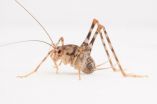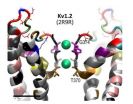(Press-News.org) Passerine birds, also known as perching birds, that migrate by night tend to fly faster in spring than they do in autumn to reach their destinations. This seasonal difference in flight speed is especially noticeable among birds that only make short migratory flights, says researcher Cecilia Nilsson of Lund University in Sweden, in Springer's journal Behavioral Ecology and Sociobiology.
Nilsson, in a group led by professor Thomas Alerstam, used a tracking radar to measure over three years the speed by which birds flew over Falsterbo Peninsula, a bird migratory hot spot in south-western Sweden. The seasonal differences they found correspond with those recorded for other nocturnal passerine migrants at other sites in southern and northern Sweden.
The seasonal differences in airspeed are more noticeable among short distance migrant birds. Nilsson and colleagues suspect that such birds fly faster in spring because they have a greater urgency to reach their breeding grounds first and to choose the best territories, mates and other resources. While the time savings made in spring might seem miniscule, these remain important because they influence the arrival order of individual birds. In autumn, the birds take things more slowly because they are not as pressured to reach their winter grounds.
Wind is the one weather condition that influences birds' decisions the most about when to take off. In fact, Nilsson and co-authors discovered that passerine birds can actually fine-tune their flights to make full use of winds, making their flying and subsequent migration easier. Short distant migrants have higher ground speeds (speed relative to the ground below) than airspeeds (own speed relative to the air around the bird) in both seasons. Hence, these birds make use of wind assistance. In contrast, long distance migrants often travel with airspeeds exceeding ground speeds, resulting from flying in headwinds, in autumn. These findings correlate with previous studies done at the University of Lund which showed that long distance migrants receive very little wind assistance on average.
Nilsson and colleagues also found that short distance migrants have a more flexible flight schedule, because they are able to wait for good nights. Long distance migrants on the other hand must fly on more nights to reach their destination in good time, even if it means traveling during unfavourable wind conditions. While waiting for nights with good wind conditions will save them energy, it will prolong their migration.
"These results indicate surprisingly fine-tuned seasonal modulation of airspeed and responses to wind. Associated with different behavioural strategies, passerine birds thus are adapted to different levels of time selection pressures during spring and autumn migration," Nilsson summarizes.
INFORMATION:
Reference
Nilsson, C. et al. (2014). Seasonal modulation of flight speed among nocturnal passerine migrants: differences between short- and long-distance migrants. Behavioral Ecology and Sociobiology. DOI 10.1007/s00265-014-1789-5
The full-text article and the image are available to journalists on request.
Migrating birds sprint in spring, but take things easy in autumn
Short-distance migratory birds have the luxury to wait until winds are just right
2014-09-02
ELSE PRESS RELEASES FROM THIS DATE:
Nano-forests to reveal secrets of cells
2014-09-02
Vertical nanowires could be used for detailed studies of what happens on the surface of cells. The findings are important for pharmaceuticals research, among other applications. A group of researchers from Lund University in Sweden have managed to make artificial cell membranes form across a large number of vertical nanowires, known as a 'nano-forest'.
All communication between the interior of a cell and its surroundings takes place through the cell membrane. The membrane is a surface layer that holds the cell together and that largely comprises lipids, built of fatty ...
Scientists find possible neurobiological basis for tradeoff between honesty, self-interest
2014-09-02
What's the price of your integrity? Tell the truth; everyone has a tipping point. We all want to be honest, but at some point, we'll lie if the benefit is great enough. Now, scientists have confirmed the area of the brain in which we make that decision.
The result was published online this week in Nature Neuroscience.
"We prefer to be honest, even if lying is beneficial," said Lusha Zhu, the study's lead author and a postdoctoral associate at the Virginia Tech Carilion Research Institute, where she works with Brooks King-Casas and Pearl Chiu, who are assistant professors ...
Researchers find Asian camel crickets now common in US homes
2014-09-02
With their long, spiky legs and their propensity for eating anything, including each other, camel crickets are the stuff of nightmares. And now research from North Carolina State University finds that non-native camel cricket species have spread into homes across the eastern United States.
"The good news is that camel crickets don't bite or pose any kind of threat to humans," says Dr. Mary Jane Epps, a postdoctoral researcher at NC State and lead author of a paper about the research.
The research stems from a chance encounter, when a cricket taxonomist found an invasive ...
Exceptionally well preserved insect fossils from the Rhône Valley
2014-09-02
In Bavaria, the Tithonian Konservat-Lagerstätte of lithographic limestone is well known as a result of numerous discoveries of emblematic fossils from that area (for example, Archaeopteryx). Now, for the first time, researchers have found fossil insects in the French equivalent of these outcrops - discoveries which include a new species representing the oldest known water treader.
Despite the abundance of fossils in the equivalent Bavarian outcrops, fewer fossils have been obtained from the Late Kimmeridgian equivalents of these rocks in the departments of Ain and Rhône ...
Surprising new role for calcium in sensing pain
2014-09-02
DURHAM, N.C. -- When you accidentally touch a hot oven, you rapidly pull your hand away. Although scientists know the basic neural circuits involved in sensing and responding to such painful stimuli, they are still sorting out the molecular players.
Duke researchers have made a surprising discovery about the role of a key molecule involved in pain in worms, and have built a structural model of the molecule. These discoveries, described Sept. 2 in Nature Communications, may help direct new strategies to treat pain in people.
In humans and other mammals, a family of ...
Single laser stops molecular tumbling motion instantly
2014-09-02
In the quantum world, making the simple atom behave is one thing, but making the more complex molecule behave is another story.
Now Northwestern University scientists have figured out an elegant way to stop a molecule from tumbling so that its potential for new applications can be harnessed: shine a single laser on a trapped molecule and it instantly cools to the temperature of outer space, stopping the rotation of the molecule.
"It's counterintuitive that the molecule gets colder, not hotter when we shine intense laser light on it," said Brian Odom, who led the research. ...
NYU study compares consequences of teen alcohol and marijuana use
2014-09-02
Growing public support for marijuana legalization in the U.S. has led to public debate about whether marijuana is "safer" than other substances, such as alcohol. In January, President Obama also publically stated he is not convinced that marijuana is more dangerous than alcohol. Despite the recent shift in views toward marijuana, the harms of use as compared to alcohol use are not well understood.
Now a new study "Adverse Psychosocial Outcomes Associated with Drug Use among US High School Seniors: A Comparison of Alcohol and Marijuana," by researchers affiliated with ...
Discovery hints at why stress is more devastating for some
2014-09-02
Some people take stress in stride; others are done in by it. New research at Rockefeller University has identified the molecular mechanisms of this so-called stress gap in mice with very similar genetic backgrounds — a finding that could lead researchers to better understand the development of psychiatric disorders such as anxiety and depression.
"Like people, each animal has unique experiences as it goes through its life. And we suspect that these life experiences can alter the expression of genes, and as a result, affect an animal's susceptibility to stress," says senior ...
Simple awareness campaign in general practice identifies new cases of AF
2014-09-02
Barcelona, Spain – Tuesday 2 September 2014: A simple awareness campaign in general practice identifies new cases of atrial fibrillation (AF), according to research presented at ESC Congress today by Professor Jean-Marc Davy from France.
Professor Davy said: "Atrial fibrillation (AF) is the most common cardiac arrhythmia. It multiplies the risk of heart failure risk by three-fold and the risk of stroke risk by five-fold. Similarly, AF is responsible for ischaemic stroke in 1 of 4 cases. However, AF is often overlooked and diagnosed too late. In 20% of cases, AF is diagnosed ...
ROCKET AF trial suggests that digoxin increases risk of death in AF patients
2014-09-02
Barcelona, Spain – Tuesday 2 September 2014: Digoxin may increase the risk of death in patients with atrial fibrillation (AF) by approximately 20%, according to results from the ROCKET AF trial presented at ESC Congress today by Dr Manesh Patel, director of interventional cardiology and catheterisation labs at Duke University Health System in Durham, North Carolina, US. The findings suggest that caution may be needed when using digoxin in complex AF patients but further studies are needed to confirm the observations.
Dr Patel said: "In this subanalysis of the ROCKET AF ...
LAST 30 PRESS RELEASES:
CHANGE-seq-BE finds off-target changes in the genome from base editors
The Journal of Nuclear Medicine Ahead-of-Print Tip Sheet: January 2, 2026
Delayed or absent first dose of measles, mumps, and rubella vaccination
Trends in US preterm birth rates by household income and race and ethnicity
Study identifies potential biomarker linked to progression and brain inflammation in multiple sclerosis
Many mothers in Norway do not show up for postnatal check-ups
Researchers want to find out why quick clay is so unstable
Superradiant spins show teamwork at the quantum scale
Cleveland Clinic Research links tumor bacteria to immunotherapy resistance in head and neck cancer
First Editorial of 2026: Resisting AI slop
Joint ground- and space-based observations reveal Saturn-mass rogue planet
Inheritable genetic variant offers protection against blood cancer risk and progression
Pigs settled Pacific islands alongside early human voyagers
A Coral reef’s daily pulse reshapes microbes in surrounding waters
EAST Tokamak experiments exceed plasma density limit, offering new approach to fusion ignition
Groundbreaking discovery reveals Africa’s oldest cremation pyre and complex ritual practices
First breathing ‘lung-on-chip’ developed using genetically identical cells
How people moved pigs across the Pacific
Interaction of climate change and human activity and its impact on plant diversity in Qinghai-Tibet plateau
From addressing uncertainty to national strategy: an interpretation of Professor Lim Siong Guan’s views
Clinical trials on AI language model use in digestive healthcare
Scientists improve robotic visual–inertial trajectory localization accuracy using cross-modal interaction and selection techniques
Correlation between cancer cachexia and immune-related adverse events in HCC
Human adipose tissue: a new source for functional organoids
Metro lines double as freight highways during off-peak hours, Beijing study shows
Biomedical functions and applications of nanomaterials in tumor diagnosis and treatment: perspectives from ophthalmic oncology
3D imaging unveils how passivation improves perovskite solar cell performance
Enriching framework Al sites in 8-membered rings of Cu-SSZ-39 zeolite to enhance low-temperature ammonia selective catalytic reduction performance
AI-powered RNA drug development: a new frontier in therapeutics
Decoupling the HOR enhancement on PtRu: Dynamically matching interfacial water to reaction coordinates
[Press-News.org] Migrating birds sprint in spring, but take things easy in autumnShort-distance migratory birds have the luxury to wait until winds are just right







